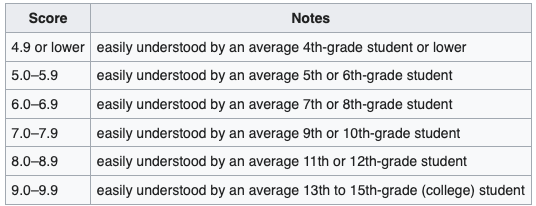The Dale-Chall readability index is useful in determining readability. Its usefulness in schools has helped determine the appropriate texts to be used especially at 4th and 5th-grade levels.
The D-C Index measures one’s vocabulary knowledge, comprehension knowledge, and language skills. One of the main features of the tool is that it helps in highlighting unnecessary words.
Doing this can help you determine whether or not the text may be worth reading.
This article will outline the Dale-Chall readability index and its use. This article will discuss when it should be used, and how to use it to measure text.
Let’s start by understanding what the D-C readability index is.

What Is the Dale-Chall Readability Index?
The Dale-Chall readability index is a formula used to calculate the grade-level reading ability of any piece of text. This is done in terms of the percentage of words a 4th or 5th grader can read and understand.
The formula implies that a piece of text’s readability will change with different settings for the document. This includes the word count, font size and style, paragraph length and structure, and use of bullet points.
The D-C readability formula was created by the University of Illinois professors Robert Dale and Robert Chall. It is commonly used to calculate the readability of web pages.
This is to make web pages available to people of all reading levels. There are other opportunities when the formula is useful.
Let’s look at when that is.
When Is the Dale-Chall Readability Index Useful?
The D-C readability index is useful when you have to evaluate how difficult a piece of text is to read or understand. The D-C index is an effort to calculate a reading grade.
It consists of three variables:
- Number of syllables
- Words with more than four syllables
- Words with more than five syllables
Using these three variables when reading or writing will help you succeed when preparing reports, writing papers, and papers. They will assess whether the text is too long or too short. This will help you determine how easy it is to comprehend the text.
The text may be difficult to read for people who aren’t used to reading, but simple for people who are. Using the D-C readability index can tell you the difficulty level of what you are reading. This can help when writing articles for a larger audience.
It can tell you how readable your article is to your audience.
How Do You Measure the Dale-Chall Readability Scores?
To get a Dale-Chall Score for web pages and other documents, you can use the Dale-Chall Readability Calculator. The greater the difficulty of the text, the higher the score.
To calculate the readability of a given text, an algorithm is used. This algorithm is based on the reading levels determined by Grade 4 & 5 readers. Here’s the formula:
0.1579 (difficult words/words X 100) + 0.0496 (words/sentence)
Note that the adjusted score is equal to the raw score. However, If the percentage of difficult words is above 5 percent, you have to add 3.6365 to the raw score to get the adjusted score.
Finally, consider using the table below to get the adjusted grade level.

Wrap Up: Accuracy of a Readability Formula
The accuracy of the Dale-Chall readability formula has received good reviews. It has been described as being quite accurate when giving a readability score.
This helps readers know whether a text is difficult to read. It also helps writers simplify their articles when writing to ensure they are easy for readers.
Dale-Chall is one of the most used readability formulas. To determine the readability of a text, a score is given. The score depends on the number of syllables in the text. The more syllables in the text, the lower the score.
In closing, remember that readability formulas are only one tool you may use to analyze text. If the grade level of the text is too low, read it aloud, so you can determine whether the text is difficult to understand.
You may also wish to ask others to read the text to get a sense of the reading level. Don’t be afraid to ask and don’t be pressured to choose one formula over another.
Choose the one that best fits your purpose. In the end, you want to get the most accurate readability score.
Explore All Readability Articles
Finding the Perfect Writing Prompts Generator
Writer’s block can affect anyone. It’s an all too familiar feeling when you stare at that blank page and scramble…
Why Read? Know the Importance and Benefits
Several distractions exist today. So the question of why read when you can be on your phone is valid. As…
Readability Vs. Legibility — Know the Difference
The distinction between readability and legibility is often confusing. These two concepts in typography are commonly mixed up due to…
6 Effective Strategies for Synthesizing in Reading
Synthesis is the ability to use multiple perspectives, insights, pieces of information, and experiences to create a new whole. In…
Understand the Right Reading Level by Age
It’s crucial to pick the right level of reading for your child because children of different ages have varying reading…
The Highest Reading Level and Why it Matters Today
Reading is one of the most essential skills that people need to develop. It is a basis for a person’s…
